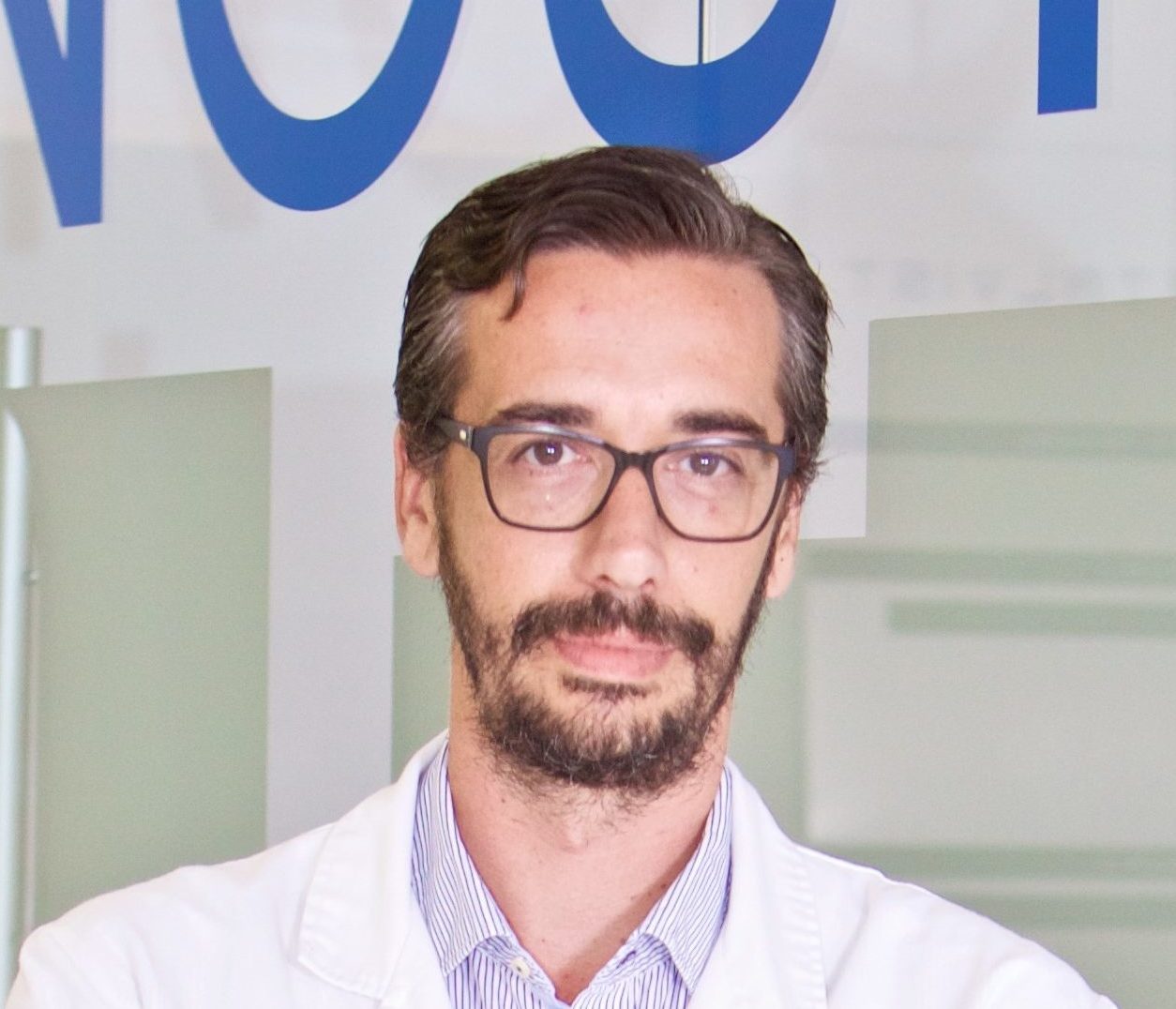touchEXPERT BRIEFING Can we improve the nAMD patient experience without compromising outcomes?
Watch leading experts discussing the multifactorial nature of nAMD, the efficacy ceiling and burden of current treatments.
Mr Hamilton highlights the dissociation between anti-VEGF therapy benefits in randomised controlled trials and real-world clinical studies, including the variability of responsiveness between patients.1–8 The contribution of additional pathways beyond VEGF to the nAMD pathology is also discussed. 9–13
1/3 Next InterviewIn this interview we asked Mr Hamilton the following questions:
- What clinical benefits have patients with nAMD demonstrated with anti-VEGF therapy in RCTs?
- How do real-world outcomes with anti-VEGF therapy differ from those in RCTs, and could dosing schedules contribute to these differences?
- Beyond VEGF, what other molecular pathways contribute to the development of nAMD?
- Are there any specific pathways that you consider more relevant?
- Do all of your patients respond in the same way to anti-VEGF or is the response more nuanced and variable? What do you think drives that variability?
Mr Robin Hamilton is a consultant ophthalmic surgeon whose range of specialties include diabetic retinopathy and maculopathy uveitis, and macular degeneration. His research interests focus on novel laser therapies for retinal disease and innovations in clinical pathways. He is also active in the field of education and is an honorary senior lecturer in the Institute of Ophthalmology in London.
Disclosures: Grant funding for advisory board work /travel support from Novartis, Bayer, Roche, Allergan Moorfields Eye Hospital and has received research funding from Bayer, Novartis, Allergan, and Roche.
Dr Gallego-Pinazo discusses the long-term outcomes for patients with nAMD, the contribution of anti-VEGF dosing schedules to real-world clinical practice and reasons for anti-VEGF undertreatment.14–19 Strategies for extending the time between anti-VEGF injections are also highlighted.22–25
2/3 Next InterviewIn this interview we asked Dr Gallego-Pinazo the following questions:
- Roughly what percentage of your patients with nAMD maintain vision in the long-term?
- In order to maintain vision long-term over 2–3 years, what kind of dosing schedule do you use for administering anti-VEGF injections?
- Which anatomical parameters matter most to you (e.g. fluid, CST, inflammation)?
- What are the key physician, patient and setting-related reasons for the outcome gap in the treatment of nAMD between trials and clinical practice?
- What challenges do physicians face in the clinical setting?
- Are there any strategies you use to extend the length of time between nAMD treatment dosing?
Dr Roberto Gallego-Pinazo is an ophthalmologist at the Macula Oftalvist Unit in Valencia and Paterna and is principal investigator of the Institute of Health Research La Fe of the OFTARED Research Institute of the Carlos III Health Institute of Madrid. He is author of over 150 scientific articles and 200 ophthalmology book chapters.
Disclosures:
Consultant: Carl Zeiss Meditec, Novartis, ORA Clinical, Roche.
Speaker: Alimera, Allergan, Heidelberg Engineering, Horus Pharma, Novartis, NTC Pharma, Roche.
Principal Investigator: Celltrion, Ionis, Iveric BioPharma, Novartis, Roche.
Prof. Bandello discusses the impact of anti-VEGF undertreatment in nAMD, and factors contributing to the burden of treatment such as appointment and travel time. 16,19,20,21 Additionally, potential future strategies to reduce the burden of treatment are
highlighted.26–30
In this interview we asked Prof Bandello the following questions:
- What do patients find burdensome about their treatment?
- How does the burden of anti-VEGF treatment affect your clinical practice?
- Would a less frequent dosing schedule help reduce the burden on patients and clinics?
- Which strategies do you use or would like to use to reduce the burden of frequent anti-VEGF intravitreal injections?
- What is the potential role of remote monitoring in reducing the outcome gap between RCTs and real-world practice?
Professor Francesco Bandello is based in the Department of Ophthalmology at the Vita-Salute University and Scientific Institute San Raffaele in Milan, Italy. He is a past President of EURETINA, President of Academia Ophthalmologica Europea and the Vice-President of EuroLam. He has co-authored 11 books and 492 PubMed articles, and has served as a trained Principal Investigator in several clinical trials.
Disclosures:
Grants: Ballergan, Bayer, Boehringer-Ingelheim, Fidia Sooft, Hofmann La Roche, Novartis, Ntc Pharma, Sifi, Thrombogenics, and Zeiss.
Paid consultant: Ballergan, Bayer, Boehringer-Ingelheim, Fidia Sooft, Hofmann La Roche, Novartis, Ntc Pharma, Sifi, Thrombogenics, and Zeiss.
Overview & Learning Objectives
Overview
Patients with nAMD treated with anti-VEGF therapy demonstrate visual gains in randomised controlled trials but long-term results in real-world clinical practice can be less consistent.1–8 We interviewed leading experts about the reasons for the gap between controlled trials and clinical practice, including the multifactorial nature of disease,9–13 dosing schedules,14–19 and the burden of dosing.16,19,20,21 Additionally, strategies to extend dosing and reduce the burden of treatment are discussed.22–30
Learning Objectives
After watching this activity participants should be better able to:
- To describe the multifactorial nature of nAMD beyond the VEGF pathway.
- To understand the disconnection between real-world outcomes and clinical trials.
- To recognise the burden for the patients and healthcare systems of current treatment options including high frequency of injections to maintain vision gains.
References
- Brown DM, et al. Ophthalmology. 2009;116(1):57-65.e5
- Rosenfeld PJ, et al. N Engl J Med. 2006;355(14):1419-31
- CATT Research Group, et al. Ophthalmology. 2016;123(8):1751-1761
- Rofagha S, et al. Ophthalmology. 2013;120(11):2292-9
- Holz FG, et al. Br J Ophthalmol. 2015;99(2):220-6
- Spaide RF, et al. Ophthalmology. 2020 127(5):616-636
- Kim JM, et al. Semin Ophthalmol. 2019;34(3):168-176
- Kim J, et al. Clin Med. 2020 9(4):1145
- Daruich A, et al. Prog Retin Eye Res. 2018;63:20-68
- Nakahara T, et al. Biol Pharm Bull. 2017;40(12):2045-2049
- Ricci F, et al. Int J Mol Sci. 2020;21(21):8242
- Saharinen P, et al. Nat Rev Drug Discov. 2017;16(9):635-661
- Sahni J, et al. JAMA Ophthalmol. 2020;138(9):955-963
- Holekamp NM, et al. Am J Ophthalmol. 2014;157(4):825-833.e1
- Holz FG, et al. Br J Ophthalmol. 2015;99(2):220-6
- Monés J, et al. Ophthalmologica. 2020;243(1):1-8
- Keane PA, et al. Clin Ophthalmol. 2015;:353-66
- Oliver-Fernandez A, et al. Can J Ophthalmol. 2005;40(3):313-9
- Prenner JL, et al. Am J Ophthalmol. 2015;160(4):725-31.e1
- Boulanger-Scemama E, et al. J Fr Ophtalmol. 2015;38(7):620-7
- McGrath LA & Lee LR. Asia Pac J Ophthalmol (Phila). 2013;2(5):295-9
- Fung AE, et al. Am J Ophthalmol. 2007;143(4):566-83
- Li E, et al. Cochrane Database Syst Rev. 2020;5(5):CD012208
- Freund KB, et al. Retina. 2015;35(8):1489-506
- Oubraham H, et al. Retina. 2011;31(1):26-30
- Hussain RM, et al. Drug Des Devel Ther. 2021;15:2653-2665
- Dugel PU, et al. Ophthalmology. 2020;127(1):72-84
- Jackson TL, et al. JAMA Ophthalmol. 2017;135(7):761-767
- Abu-Yaghi NE, et al. Int J Ophthalmol. 2014;7(6):1017-21
- Nahen K, et al. Klin Monbl Augenheilkd. 2020;237(12):1410-1418



